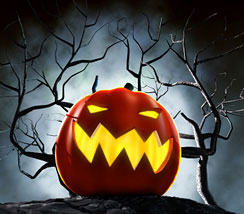What Makes a Story Scary?
 I can think of a few things that scare me: rejection letters, unpaid bills, and me in a thong. But I'm talking really scary, the things that send chills up your spine when you read a short story. It takes a certain type of writer who can plow the depths of darkness, build suspense, and twist a story ending so the reader doesn't see it coming.
I can think of a few things that scare me: rejection letters, unpaid bills, and me in a thong. But I'm talking really scary, the things that send chills up your spine when you read a short story. It takes a certain type of writer who can plow the depths of darkness, build suspense, and twist a story ending so the reader doesn't see it coming.What are some other elements scary stories need in order to be truly scary? Here are a few tips from a great book on horror writing, aptly named On Writing Horror, by the Horror Writers Association.
Suspenseful Beginnings:
You might launch your story with the mud having already filled up the entire basement and swallowed the plumber, but it's far creepier to show the mud growing mysteriously over time before the plumber kicks the bucket. You want to find a starting place close enough to the action to be compelling but distant enough to allow for suspense; that's a delicate (and difficult) balance to strive for in every story.
Find the Thing that Frightens You:
Giving a strategic glimpse of what frightens you can lessen the effect of writing about that thing's impact on you, and it can, at the same time, increase the impact of that thing (whatever it is) on your readers. Find the single facet of that thing that frightens you--that which most everyone can relate to--and use that one facet as a weapon to frighten your readers.
End with a Twist:
An ending that defies expectation and adds a new twist can make for a memorable story, but please remember, I said twist, not gimmick. The gimmick, that which is utterly unexpected because there has not been even a telepathic hint of its possibility, risks totally blowing the suspension of disbelief and ruining all your previous hard work.
Those are just a few excerpts from On Writing Horror. If you are a horror writer, it's a great reference book that you'll want on your shelf.
The popularity of horror novels and stories attest to the fact that most of us love a scary story. They get our blood pumping, our adrenaline rushing, and bring out our most primal instinct: fear.
Here are a few things that make a story scary for me:
- The fear of what could happen
- The probability that it will happen
- Believability, even if the subject matter may seem unbelievable
- If the story is true
Labels: horror writing tips, scary story, short story writing












4 Comments:
You're such a humorous writer...I knew in just reading the first sentence that this was going to be another awesome Angela blog post :)
That said, excellent question at the end. I would say it's in the pacing of the narration. Just like a good comedian has that timing down when it comes to the punch line, so too, the strongest horror fiction writers and movie directors have the eye, ear, and mind for the perfect pacing.
If the pacing isn't quite right, the cover's blown and the scare factor is destroyed; the creative side of our mind doesn't get to build up that fear or start questioning what's going to happen next? However, if the pacing is too slow, I get bored and walk away...
So true, Alison. :) Pacing has to be right, and it's such a tough thing to figure out. I find, in my fiction writing, that sometimes I tend to draw things out too much. You know how it is...as a writer, you fall in love with your prose and it's hard to cut. But if it's not moving the story forward, it should be cut so readers don't get bored. Sigh.
Another thing that really works with horror writing (well, any writing) is vivid description--both of setting and things. By "things" I'm talking monsters, creatures and such. If they aren't described really well there's no way a reader's going to buy into it.
I totally admire those who can craft a story that really scares you. Reading a scary story is so much better than watching a horror flick. I'm so disappointed in scary movies. They just don't scare me anymore. Maybe I'm getting old, LOL, but they just seem so formulaic.
Happy Halloween!
I think the most frightening stories are the ones that could actually happen such as the stranger in your house with an axe. The closer written to reality,the better. Stories like The Shining, where people go mad and everything is out of your control not only scare you, but make you think!
Post a Comment
Links to this post:
Create a Link
<< Home